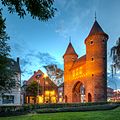Lüdinghauser Tor
The Lüdinghauser Tor is part of the former city fortifications of Dülmen . It is located at the exit of Dülmen city center on Lüdinghauser Strasse in the direction of Lüdinghausen .
The Lüdinghauser Tor is the landmark of Dülmen .
history
The gate (or Lüdinghauser Pforte or Ludinchuser Porten) was probably built in the 14th century as a wooden gate as part of the city fortifications. The stone towers were built at the end of the 15th century, with a wooden battlement serving as a connection . Guns were erected at the gates and walls, two of which were at the Lüdinghauser Tor from 1584. The battlements and the gate building that had been erected in the meantime disappeared over time. The gatehouse was demolished in 1836 when the collection of road tolls was banned. Until 1906, one of the towers also served as a city prison.
As early as the middle of the 19th century, the towers of the Lüdinghauser Tor were considered a traffic obstacle, but the government forbade their demolition. In the course of the ban, a pedestrian passage was broken first in the western and later in the eastern tower. In 1908, as part of the preparations for the city's 600th anniversary in 1911, the two towers were re-covered and the stone connection was also built as a characteristic central building.
The Lüdinghauser Tor was used by the National Socialists from 1938 to 1945 as the city's coat of arms (instead of the trefoil cross). When it was rebuilt after it was destroyed in World War II, the gate received its current special status - and is still a traffic obstacle.
literature
- Erik Potthoff, Dietmar Rabich: Dülmen - yesterday and today . 1st edition. Laumann-Verlag, Dülmen 2013, ISBN 978-3-89960-397-2 , Dülmen - Innenstadt, Lüdinghauser Tor, p. 44-47 .
- Frauke Heidemann: View over the Lüdinghauser Tor into the city of Dülmen , Dülmener Heimatblätter , issue 2/2007 (PDF file; 608 kB)
Web links
- Michael Schreiber: Panorama view ( http://www.stadtpanorama-duelmen.de/Panoramen/42/42.html ), Stadtpanorama Dülmen.
Coordinates: 51 ° 49 ′ 41.8 ″ N , 7 ° 16 ′ 48.5 ″ E






